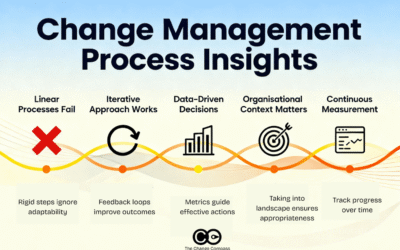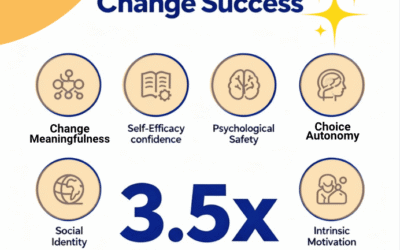What are the key benefits of best practice change management process in an organization?
Effective change management enhances organizational change management agility, boosts employee engagement, maximises change efforts and minimizes resistance to change. This can apply to digital transformations or other types of significant changes. It fosters a culture of adaptability to new business processes, ensuring that teams can navigate transitions smoothly. Ultimately, it leads to improved productivity, better communication, and higher overall satisfaction among employees and stakeholders alike, driving long-term success.
In the corporate world, most approaches in defining the business value of change involve hard benefits such as revenue, cost, and time. For example, increased revenue per customer, reduced people costs, and improvement in processing time. Yes, there are non-financial benefits such as capability improvement and strategic alignment. However, in practice, most tend to focus more on hard benefits that are more tangible and easier to track.
The problem is that benefits are usually defined in a top-down, linear way and have not taken into account the environment that determines the benefits. For example, a Strategy department defines the need to cut people costs by 10% and therefore the analysis will subsequently focus on headcount reduction or pay and benefits reduction. Finance will therefore work with HR and the business to start defining which headcounts to cut and any opportunities to reduce pay and benefits. A list is then gathered to report on potential cost savings in dollar terms.

What is wrong with this scenario of defining benefits for organisational change?
On paper, everything looks fine, but without actually involving those managers in business and understanding the environment in which the costs will be saved it is hard to determine the actual benefits. How much influence do these roles have on the organization from lateral networking and influencing perspective? Can any of these roles be critical in implementing the change process? What are the potential impacts in service delivery resulting from these cuts? The learning here is that top-down analysis of benefits can often only be treated as high level and we need to work within the organization to find out the real benefits.
In a previous role, an IT department wanted to reduce the $25 per call for employees to change their passwords. When I started finding out more about the experience and the process for an employee to change passwords the discovery I made was quite shocking from an employee morale perspective. The $25 was negligible compared to the real cost. For example, my team member Barbra just returned from maternity leave and had forgotten her login password. She rang the Helpdesk 4 times to try and retrieve her password but was unsuccessful for some reason. Barbara became increasingly irate. We’ve heard her screaming at the phone, taking breaks to calm down, and talking to others to express her frustration. For days she was not able to log on. For Barbara’s case, the company has lost the equivalent of 3 days in productivity to the tune of $2500. We’ve also found other similar cases.
So how might we better analyse and assess the benefits of change initiatives?
Change management professionals can do this by observing the environment for those impacted by the change initiative, or the employee or customer experience. Utilise human-centred approaches in observing the employee or the customer and how the initiatives may impact their lives. These include observation of key stakeholders as a part of the overall change program, seeing the whole picture by putting yourself into their shoes, identifying the impacts on various people and processes, and if needed interviewing them after observation to find out more. What else will be happening in their worlds other than the change initiative in concern? Will there be risks of overlaps or time conflicts for different initiatives?
Change managers can tally various sources of benefits observed. Who are the people potentially impacted by the change initiative? What processes and systems are impacted by the new technology or new software? Therefore, what are the sources of potential benefits in terms of time, cost, or revenue? Have a chat with your business leaders to confirm on these.
Test change initiative and benefits before large-scale rollout
As a part of the change management practices, test at a smaller scale initial change implementation approaches on the selected target audience and observe the effects of change and resulting benefits. Take an proactive approach to experiment and tweak these approaches before larger-scale implementation.
What are the key benefits of effective change management in an organization?
Effective change management enhances organizational agility, improves employee engagement, and boosts productivity. It minimizes resistance to change by fostering clear communication and support, leading to smoother transitions and minimise unrealized benefits. Ultimately, these benefits contribute to sustained growth and a competitive edge in today’s rapidly evolving business landscape.
To read more about calculating the financial benefit of managing a change portfolio visit our article here.






